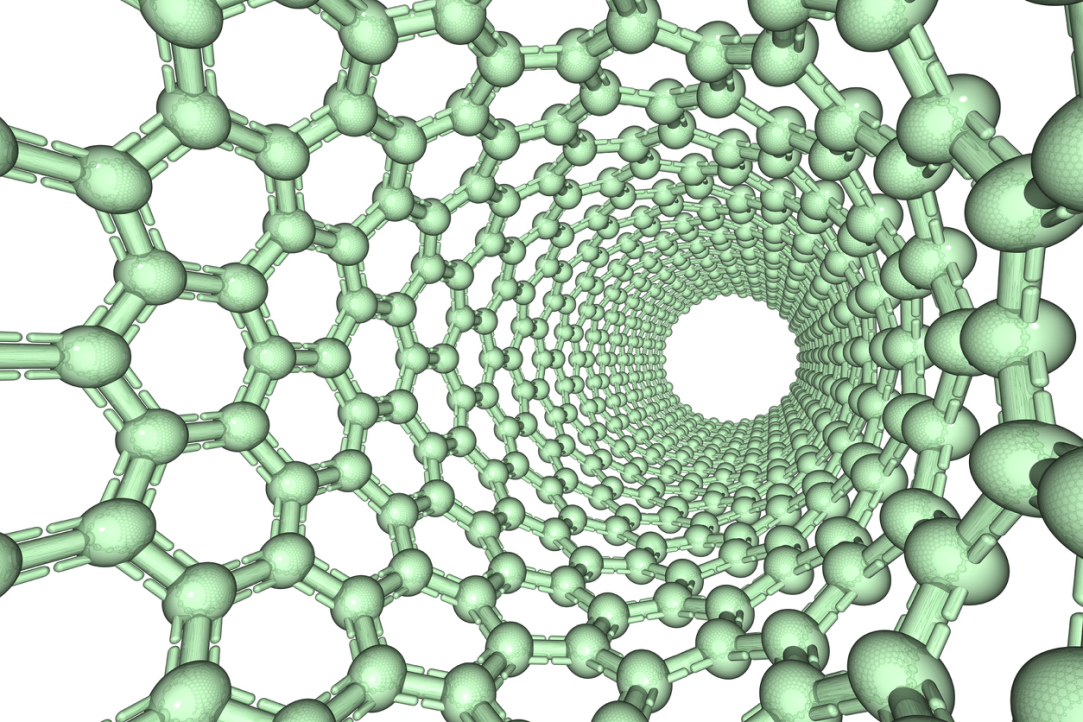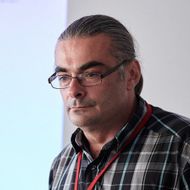Tunnelling Contact Helps to Study Electron Structure of Carbon Nanotubes

Russian physicists have demonstrated how tunnelling contacts can be used for single-particle states spectroscopy in carbon nanotubes. The proposed technology of tunnelling contact fabrication and the spectroscopic method will help measure the exact nanotube bandgap value, which is the key characteristic required for design of any nanotubes-based electronic devices. Applied Physics Letters publishes the result of the study.
Carbon nanotubes are unique entities in their physical nature and properties. They have been researched extensively over the past three decades and have applications in various fields of science and technology, including materials studies, physics, and electronics, to name but a few.
A carbon nanotube can be compared to a rolled graphene sheet. The properties of carbon nanotubes are truly unique, as the way in which this sheet is rolled up determines the bandgap width, which, in turn, determines the semiconducting or metallic properties of a nanotube. Consider an ordinary piece of paper: it can easily be rolled up into a tube by joining either two opposite sides or two opposite corners; alternatively, one corner can be joined to any point on the opposite side. The properties of a sheet of paper do not depend on exactly how it is rolled up. If we now replace the sheet of paper with a small piece of graphene it turns out that it will behave either like a semiconductor or like a metal in terms of its conductivity depending on which way we rolled the graphene into a tube. This behaviour makes carbon nanotubes a very attractive material for building all sorts of electronic devices.
The bandgap width is the main characteristic of semiconductors, which is primarily responsible for their applications. At this stage of technological development, no good method for growing carbon nanotubes with known bandgap widths has yet been devised. The synthesis process can produce carbon nanotubes with varying bandgaps, or even no bandgap at all. To determine the bandgap width and the specific type of electron energy distribution, tunnelling spectroscopy has traditionally been used for each individual tube using a tunnelling microscope. This method has a number of disadvantages; it is imprecise, expensive, and non-technological.

In the published study, researchers proposed a technologically advanced (ie, highly compatible with current electronics fabrication techniques) and scalable method to determine the electron spectrum of an individual carbon nanotube. The researchers fabricated a tunnelling contact (see Figure (a)), which is a contact with a very high electrical resistance. Rather than directly, the metal of the contact interacts with the tube through a thin dielectric layer (see Figure (b)).
‘The dielectric creates a tunnel barrier, an energy wall that prevents transfers of charge carriers. A “classical” particle cannot cross such a barrier, but quantum mechanics “allows” a conduction electron or a hole to pass through the barrier, or to “tunnel”. It is worth noting that the probability of tunnelling is proportional to the density of states in the object under study. Because of this property, tunnelling contacts allow for scanning electron energy distribution in the tube,’ says Yakov Matyushkin, one of the study's authors, a Junior Research Fellow at the MIPT Laboratory of Nanocarbon Materials and a HSE MIEM research assistant and doctoral student.
The researchers made a series of samples, each of which was a single carbon nanotube with two pairs of ohmic and two pairs of tunnel contacts (see Figure (a)). The researchers first grew the tube on a silicon substrate. After that, they attached the tunnelling and ohmic contacts to it. During the experiment, voltage was applied between the tunnelling contact and the ohmic contact at the temperature of liquid helium and the electric current, which flowed through the system was measured. The dependence of the current on the voltage made it possible to obtain the electron spectrum in a carbon nanotube and determine the bandgap width.

Georgy Fedorov
'The proposed method provides information about the band structure of carbon nanotubes. It also helps in determining how this structure changes under the influence of external factors. For instance, we observed the removal of valence degeneracy in a magnetic field using tunnelling contact. This long-predicted effect manifests itself in energy splitting of state density maxima. This is the first time we have demonstrated this effect in an individual nanotube,’ says co-author Georgy Fedorov, Deputy Head of the MIPT Laboratory of Nanocarbon Materials.
The samples were made by the MIPT Laboratory of Nanocarbon Materials based on the MIPT Shared Facility Centre. The experiments were carried out by the Radiophysics Laboratory, Moscow State Pedagogical University, and by the MIPT Shared Facility Centre for Studies of HTS and other Strongly Correlated Materials (SFC LPI).'
The research was supported by the Russian Foundation for Basic Research, the Russian Science Foundation, and the Russian Ministry of Education and Science.
Yakov Matyushkin
See also:
HSE Scientist Optimises Solution of Hydrodynamics Problems
Roman Gaydukov, Associate Professor at the MIEM HSE School of Applied Mathematics, has modelled the fluid flow around a rotating disk with small surface irregularities. His solution allows for predicting fluid flow behaviour without the need for powerful supercomputers. The results have been published in Russian Journal of Mathematical Physics.
Physicists from Russia and Brazil Unveil Mystery behind Complex Superconductor Patterns
Scientists at HSE MIEM and MIPT have demonstrated that highly complex spatial structures, similar to the intricate patterns found in nature, can emerge in superconductors. Mathematically, these patterns are described using the Ginzburg–Landau equation at a specific combination of parameters known as the Bogomolny point. The paper has been published in the Journal of Physics: Condensed Matter.
Adhesive Tape Helps Create Innovative THz Photodetector
An international team of researchers, including scientists at HSE University and Moscow Pedagogical State University (MPGU), has developed a novel photodetector composed of a thin superconducting film, capable of detecting weak terahertz (THz) radiation. This discovery holds promise for studying objects in space, developing wireless broadband communication systems, and making advancements in spectroscopy. The study has been published in Nano Letters.
Operation of Cellular Networks Found Similar to Bacteria Growth in Petri Dish
Scientists at the HSE Laboratory for Computational Physics have developed a new model for analysing communication networks that can significantly enhance the speed of mobile communications. To achieve this, the researchers used computational physics methods and phase transition models. It turns out that the functioning of cellular networks is in many ways similar to the growth of surfaces in physics. The study was performed using the HPC cHARISMa cluster at HSE University. The study findings have been published in Frontiers in Physics.
The Saudi Arabian National Team, Medal Winners at the International Physics Olympiad, Trained at HSE University
At the recent International Physics Olympiad (IPhO 2024) in Iran, students from Saudi Arabia achieved the best results in their country's history, winning one silver and three bronze medals. The team from the Kingdom made their first visit to Russia to receive their final training at the HSE Faculty of Physics.
'I've Always Been Keen to Engage in Experiments and Operate Scientific Instruments'
During his early years at university, physicist Ivan Makhov worried that he might be dismissed, but today he is heading a study supported by a grant from the Russian Science Foundation. In this interview with the HSE Young Scientists project, he shares his work experience using a closed-loop cryostat, his dream of conversing with Einstein, and favourite location in his hometown of St Petersburg.
‘Two Interdisciplinary Research Centres Can Create New Synergy between Themselves’
In mid-June 2024, HSE University and the Joint Institute for Nuclear Research in Dubna held a joint working meeting. This meeting was the first under an agreement signed by the research centres in 2024, when HSE University and JINR agreed to jointly participate in experiments of the NICA megascience project, as well as interact in the field of theoretical and mathematical physics, information technology, and personnel training. These issues were the focus of the first working meeting. Details are in the JINR report.
‘I Aspire to Make a Contribution Comparable to Prometheus' Gift to Humanity'
Egor Sedov initially planned to pursue a career in programming but instead became captivated by experimental physics. In this interview with the HSE Young Scientists project, he spoke about the quantum effect and the quantum standard, a scientist's letter from the future, and the magnetic levitation of a frog.
Russian Scientists Pioneer Accurate Mathematical Description of Quantum Dicke Battery
Physicists at HSE University and NUST MISIS have formulated and solved equations for a quantum battery, a device capable of storing energy in the form of light. Their findings will facilitate precise calculations of the capacity, power, and duration required for optimal battery charging. Quantum batteries are expected to improve the performance of solar panels and electric vehicles, while also opening up new avenues for efficient energy transfer. The study has been published in Physical Review A.
Scientists Harness 'Liquid Light' to Induce Electric Current in Superconductors
Scientists at HSE MIEM have induced a superconducting current using 'liquid light,' or excitonic polaritons, which are hybrid particles formed by interaction between light and matter and possess the properties of both light and material particles. The ability to manipulate an electrical system through an optical one can be valuable in the development of technologies such as quantum computers. The study has been published in Physical Review B.


